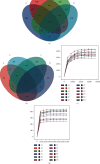Comparison of Bacterial and Fungal Community Structure and Potential Function Analysis of Yak Feces before and after Weaning
- PMID: 36082156
- PMCID: PMC9448584
- DOI: 10.1155/2022/6297231
Comparison of Bacterial and Fungal Community Structure and Potential Function Analysis of Yak Feces before and after Weaning
Abstract
Weaning is one of the most stressful periods in yak growth. However, the impact of weaning on microbial diversity, structure, and potential function of yak feces is not clear. In this study, 12 Xinjiang yaks aged 3, 4, 5, and 6 months old were selected to collect fresh feces before and after weaning. Through 16S rRNA and ITS high-throughput sequencing, the dynamic distribution and potential function of yak fecal, bacterial, and fungal communities in each month were revealed. The study found that the richness of fungi had a significant impact on weaning. At the phylum level, Firmicutes, Bacteroidetes, Ascomycota, and Basidiomycota, and at the genus level, 5-7N15, Oscillospira, Roseburia, Dorea, Preussia, Neoascochyta, Naganishia, and Sporormiella were enriched in yak feces of different months old. The abundance and proportion of bacteria Firmicutes, Bacteroidetes, 5-7N15, and fungi Mucoromyceta changed significantly before and after weaning. With the increase of months, Verrucomicrobia and Akkermansia have shown a downward trend. Through the prediction and analysis of fecal microbial function, it was found that at the level of primary pathways, weaning has a significant impact on cellular processes, environmental information processing, genetic information processing, metabolism, and organismal systems. At the level of secondary metabolic pathways, weaning has a significant impact on cell motility, signal transduction, folding, sorting and degradation, translation, amino acid metabolism, glycan biosynthesis and metabolism, metabolism of terpenoids and polyketides, and xenobiotics biodegradation and metabolism. In addition, by analyzing the differences in functional pathways and microbial composition between sample groups of different months, it was found that the differences in functional pathways were related to the abundance differences of some microorganisms. In general, the changes in the composition and structure of yak fecal microflora may reflect the adaptability of the intestinal microbiota.
Copyright © 2022 Yuanyuan Li et al.
Conflict of interest statement
The authors declare no conflict of interest.
Figures






References
-
- Zhang L., Sun B. Z., Xie P., et al. Using near infrared spectroscopy to predict the physical traits of Bos grunniens meat.LWT - Food Science and Technology . 2015;64:602–608.
MeSH terms
Substances
LinkOut - more resources
Full Text Sources

